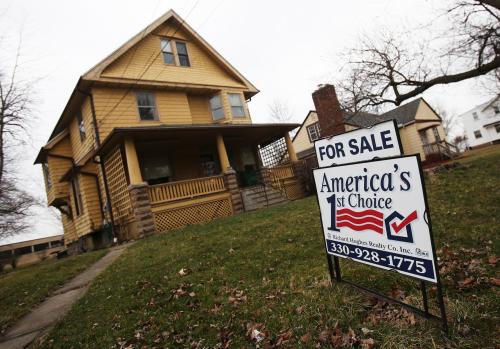Language is constantly evolving. Reflecting the fluidity of labels used within the Latino community, the following terms are used across the article, often interchangeably: Hispanic, Latino, and Latinx. By no means is this list exhaustive, and in future pieces we anticipate using additional terms, including Latine.
In the lead-up to the 2024 presidential election, Latino voting behavior will be widely discussed, as Latino voting patterns are remarkably nuanced and vary by region, age, gender, and national origin, among other factors. Candidates, campaign consultants, journalists, and policymakers should expect economic issues to be a top concern for Latinos, as in previous election cycles. In light of this, it is worth examining Latinos’ current economic condition in the United States.
According to the 2019 Survey of Consumer Finances (SCF), significant wealth disparities exist between families of different races and ethnicities, including between white households and Hispanic/Latino households. White families have a median wealth of $188,200, whereas Hispanic families have a median wealth of $36,100. Another way to look at the SCF data is that the average white family has five times the wealth of the average Hispanic family.
This data raises important questions. What is the context behind the numbers? How did we arrive at such disparities? And is there even such a thing as “the average Hispanic family?”
Though Latinos have been one of the fastest-growing demographic groups in the United States for decades, the underlying causes of the wealth gap between Latino and white families are often misunderstood, resulting in the prioritization of smaller-scale programmatic solutions over larger-scale policy ones. Public narratives about Latinos’ economic condition place far too much emphasis on individual behaviors of the group, rather than structural factors such as discrimination, racism, and segregation. For example, efforts to address disparities in wealth tend to concentrate solely on fixing Latino behaviors and decisionmaking by providing financial literacy resources, as opposed to pairing these with policy solutions to address systemic barriers that prevent Latinos from building wealth in the first place.
Critically, Latinos are extremely diverse, and policy work must address the wide range of starting points and lived experiences they possess and how these differentiators correlate with wealth-building. Among these are Latinos’ racial diversity, immigration status, socioeconomic status upon entry into the U.S., generational distinctions, and even regional differences.
Brookings Metro is exploring and addressing these questions creatively and rigorously by deploying the Brookings platform and regional insights to conduct cutting-edge research on Latino wealth; develop policy frameworks and tools for federal, state, and local policymakers; and host convenings on the topic.
As part of this project, this report serves as the first in a series at Brookings Metro examining Latino wealth. This report outlines some basic building blocks and approaches to better understanding the state of Latino wealth, Latino assets and debt, and the context behind the numbers. From there, stratification economics is introduced as a framework for understanding wealth disparities—moving the focus away from individual behaviors and instead toward the structures and processes that create and maintain social and economic disparities.
To understand Latinos’ economic position in the United States, one can examine their wealth. Wealth paints a holistic picture of a family’s economic security and prospects for upward mobility. A generation ago, scholarship such as Michael Sherraden’s “Assets and the Poor” and Melvin Oliver and Thomas Shapiro’s “Black Wealth/White Wealth” underscored the importance of centering assets and wealth for addressing economic inequality. As this and other research points out, it is a family’s wealth—not just income—which allows them to make a down payment on a home, pay for their children’s college education, or start a business with seed capital. Wealth also provides families and individuals with the ability to weather financial storms, including recessions.
Wealth, in the simplest terms, is what you own minus what you owe. Wealth is sometimes referred to as “net worth,” and is measured by considering the difference between assets and liabilities. Assets can include savings and checking accounts, stocks, retirement accounts, business equity, vehicles, and homes and other real estate. Liabilities can include credit card debt, medical debt, student loan debt, mortgages, auto loans, and family loans.
Available wealth and wealth gap estimates will vary depending on the source (and whether one is using mean or median values). There are a number of national surveys that look at wealth for all Americans, including Latinos. There are also some one-time surveys that focus specifically on Latinos or on racial and ethnic groups at detailed, ancestral origin levels. Nonetheless, much more work and data—disaggregated data in particular—are needed to better understand the nuances and diversity of Latinos and subgroups of Latinos.
Presently, three main surveys collect periodic information on wealth:
- Survey of Consumer Finances (SCF) is sponsored by the Federal Reserve Board, and the survey is conducted every three years. This survey over-samples wealthy households to estimate wealth and narrowly held assets more precisely and to correct for nonresponse, which is higher among the wealthy.
- Panel Study of Income Dynamics (PSID) is the world’s longest-running longitudinal household survey, with over 50 years of data from the same families and their descendants. The survey is administered by the University of Michigan and is conducted every other year.
- Survey of Income and Program Participation (SIPP) is a longitudinal study administered by the U.S. Census Bureau. This survey over-samples households from high-poverty concentration areas to improve the ability to measure participation in government programs.
Other surveys, such as the National Asset Scorecard for Communities of Color (NASCC), are one-time surveys collecting data on the asset and debt positions of racial and ethnic groups at a detailed, ancestral origin level in targeted metropolitan areas. The NASCC replicates questions from the PSID to collect asset and debt information, but it also solicits information regarding remittances behavior, use of payday lenders, and homeownership and foreclosure experiences.
More recently, there have been a number of reports that aim to benchmark how Latinos are doing economically, such as McKinsey’s series on the economic state of Latinos in America. To examine and analyze family net wealth and the role of savers and investors, McKinsey’s report uses the SCF and data from their own propriety survey to understand the differences in wealth for Latinos based on origin and place of birth. They also reference research and data published by other research entities, such as Bank of America, the Hispanic Wealth Project, and the Pew Research Center.
According to the 2021 McKinsey series report, Latino wealth has grown by an average of about 7% annually for the past 20 years, which is more than twice the rate of non-Latino white wealth. The report also notes that the median value of net worth for individual Latinos in the U.S. is increasing by generation—particularly from first to second generation Latinos. However, they also find that significant disparities still persist, particularly between Latino and non-Latino white wealth.
Data from the 2021 SIPP (Table 1) indicates that significant differences in asset ownership—not solely debt—may be driving some of these wealth disparities. When Latino households have assets, their median and average values are lower than those of non-Latino white households. For example, though a significant portion of Latino wealth is in housing assets and vehicle equity, the values of those assets are lower than those of non-Latino white households. This data also reflects Latinos’ under-indexing in businesses, stocks, mutual funds, life insurance, and other assets that can increase their net worth.
Disparities in non-retirement financial investments—such as stocks, bonds, and mutual funds—are worth examining further, as evidence suggests that gaps in non-retirement equity ownership have contributed to the widening of the racial wealth gap. For example, in recent decades, stock equity appreciated at higher rates than other assets such as housing, and these differences in asset appreciation have largely benefitted white households. This evidence also highlights the need to examine Latino wealth gains (or losses) over time to gain insight into generational differences, pathways to social mobility, and risk factors that could result in losses over time. The data presented in this piece is a snapshot in time; future work at Brookings Metro will aim to piece together Latino wealth over the long term.
Additionally, Latinos also have lower participation and allocation in retirement accounts. Among the reasons for these participation gaps is unequal access to retirement plans, as some employers do not offer plans or some families are not eligible for employer-sponsored plans. Immigration status also plays an important role, as one’s status impacts the types of jobs one is able to get, as well as qualifications for certain job benefits, including retirement plans—which in turn impacts the assets they can grow.
Liabilities (or debt) form the other half of the net worth equation.1 According to the 2021 SIPP, home and vehicle debt make up most of Latinos’ secured debt (Table 2). Despite the fact that vehicle debt does not often get as much attention as mortgage debt, it certainly has policy implications, especially if we examine how certain communities accumulate such debt in the first place. As an example, numerous reports have documented racial and ethnic disparities in auto sales, financing, and insurance. According to the National Consumer Law Center, Latino and Black consumers face higher car financing costs, even if their credit scores, incomes, and other indicators of credit worthiness are just as good as those of white consumers. They also found that in 44 states, Hispanics paid higher percentage markups for service contracts than non-Hispanics. Thus, seeing that not all debt is created equally or fairly, Latinos would benefit (and could likely see some of their vehicle-related debt decrease) if government officials and policymakers bolstered efforts to target discrimination in auto sales and lending.
In terms of unsecured debt, about 47% of Latino households have credit card debt, compared to 46% of Black households and 40% of white households. This data is worth monitoring over the long term, especially given a recent survey from the Consumer Financial Protection Bureau (CFPB) noting that between 2021 and 2022, Hispanic households’ finances deteriorated rapidly and their credit card debt increased significantly, especially as their incomes became more variable during this period and they struggled to cover monthly expenses.
In the same vein, given their tremendous diversity, we need to continue to examine how Latinos and subgroups of Latinos (for example, Afro-Latinos versus white-identifying Latinos or Latinos of different national origin groups) use and accumulate debt—and critically, how different types of debt impact them. In a seminal piece, “Black Debt, White Debt,” Louise Seamster stressed the importance of studying debt to understand the racial wealth gap, especially in light of the increasing dependence on debt in the economy. Seamster noted that there are many different types of debt products (e.g., payday loan debt versus mortgage debt), as well as different terms (such as discriminatory interest rates) on the same products. There are also different returns on debt for white and Black families, as a result of intergenerational wealth differences, neighborhood home value differences (e.g., the devaluation of Black assets), and post-graduation wage gaps.
Seamster also outlined many racialized dimensions of debt, including the way that “good debt” correlates highly with “white debt,” while “bad debt” correlates highly with “Black debt.” For example, mortgages would be an example of “good debt,” and it is also a type of debt that can be used to build wealth. White families tend to have higher mortgage debt than Black and Latino families. Meanwhile, “bad debt” can come in the form of alternative financial services such as payday loans and title loans, which Black and Latino people are more likely than white people to depend on because there are fewer banks in Black and Latino neighborhoods.
Given the racial diversity among Latinos, it is worth exploring how structural advantages or disadvantages may lead them to encounter “good debt” versus “bad debt,” as it is presently unclear which subgroups of Latinos encounter which type of debt.
Though the data presented above is helpful in making comparisons across different groups (namely, between Black, white, and Latino communities), data on Latino wealth in aggregate can assume homogeneity—masking crucial differences in Latinos’ wealth-building experiences, as has been seen with other communities, such as Asian Americans and Pacific Islanders (AAPI).
For Latinos, there are regional differences among groups, as well as considerations regarding racial and ethnic diversity, Indigenous identity, age, gender dynamics, and timing of migration and immigration. For instance, when looking for a first home in Miami, a third-generation Cuban American woman might be more concerned about rapidly rising mortgage rates and housing prices. She may approach building wealth differently than a Mexican, undocumented college graduate in Chicago who sets his financial planning goals in shorter-term increments due to Deferred Action for Childhood Arrivals (DACA) considerations. Meanwhile, in the Washington, D.C. area, a Salvadoran day laborer might not have the luxury of thinking about wealth-building because he is more concerned with accessing basic banking services to avoid being viewed as a “walking ATM.”
One important development in the 2021 SIPP is that the demographic data now includes “detailed Hispanic origin” variables, so we can see assets and liabilities data for various Latino groups, including Mexicans, Cubans, Puerto Ricans, Dominicans, Salvadorans, and Colombians. This detailed data is crucial for understanding the wealth disparities that exist across different Hispanic-origin groups. For example, the table below estimates household net worth using information from all household members for persons of a given Hispanic origin. The net worth differences among individuals from these origin groups reflect a range of factors, such as the length of time these groups have been in the United States; their immigration or citizenship status; the initial socioeconomic status of migrant groups upon entry into the U.S., particularly pre-immigration financial and human capital upon entry; and the public policies and market circumstances that impacted wealth creation for these groups across time and place.
These wide ranges in median household net worth also indicate that one-size-fits-all policies may not be suitable for groups at either end of the spectrum. Moreover, as others have found with AAPI subgroups, policy decisions based on aggregated data rather than disaggregated data may lead to underserving some subgroups.
Latino wealth data is crucial for designing policy solutions to address wealth disparities. However, the analysis of this data and promotion of solutions may differ depending on the field or lens through which they are viewed. Traditionally, for example, mainstream economics explains wealth disparities between groups as they relate to differences in either human capital or a lack of economic competition. Meanwhile, in public policy discourse and even mainstream media, a misunderstanding of how Latinos build wealth fuels misguided attempts to address the symptoms of wealth disparities rather than the underlying causes. Thus, we often see explanations of wealth accumulation or disparities tied to individual and community characteristics, such as values, beliefs in personal responsibility, cultural practices, or other group behaviors. Focusing on Latino behaviors, however, suggests that if someone has not built wealth, they are essentially making poor decisions intentionally or unintentionally—when in truth, they may face constrained choices or factors outside of their control, including discriminatory barriers.
In light of this context, stratification economics may provide a useful framework for understanding wealth disparities. The interdisciplinary field of stratification economics studies and explains wealth disparities in which social relationships, power dynamics, and public policies shape the outcomes of different groups. Stratification economics focuses less on the individual and more on the structural and intentional processes by which economic and social disparities are maintained, created, or addressed. William “Sandy” Darity, Jr., one of the founders of stratification economics, put forth the following assumptions, as summarized by the Washington Center for Equitable Growth:
- Disparities in groups’ abilities to transfer resources across generations are key drivers of inequality.
- Dominant groups have material interests in actively maintaining their privileged positions.
- Effective public policy is essential to push against discrimination and foster more equitable outcomes.
- The acquisition of human capital does not guarantee that members of an underprivileged group will not experience the economic penalties that stem from discrimination.
- Dysfunctional behavior by some individuals is not reflective of a collective characteristic of a broader group.
One of the key factors contributing to wealth disparities can be better understood if we examine the first insight: the transfer of resources across generations as a driver for racial wealth gaps. Families can transmit wealth and resources in a variety of ways. For example, families can bequeath their wealth directly to the next generation. They can also provide gifts to their children and grandchildren, such as down payment assistance for a home purchase. Presently, wealth-holding is relatively high among white households because white households are more likely to have received an inheritance or gift. According to the 2019 SCF, Hispanic families are both less likely to receive an inheritance and less likely to expect to receive an inheritance: about 4% of Hispanic families expect an inheritance, compared to 17% of white families, 6% of Black families, and 15% of other families. White households also tend to receive much larger inheritances compared to other groups.
Using the lens of stratification economics, we can understand these disparities as the result of long-term processes in which social policies and practices prevented certain groups, such as Black and Latino communities, from building wealth (such as through homeownership) that could be passed down from generation to generation. In this case, white families who were not discriminated against could, for example, accumulate wealth and pass it on to their children and grandchildren.
U.S. foreign policy and immigration policies can also affect a family’s ability to pass down wealth. For example, different Latino origin groups (and even people within the same origin group) have different immigration statuses or privileges associated with those statuses, such as welfare, work authorization, and resettlement support, among others. In addition to certain privileges, some immigrants, like the first wave of Cuban immigrants, also came to the U.S. with a higher socioeconomic status (and capital). Since wealth begets wealth, these variables may have led to greater and faster gains compared to other groups. In other situations, undocumented immigrants or those denied asylum during certain periods (such as Central Americans) lack rights, work authorization, or other privileges because of their immigration status, which may limit their opportunities for both building wealth and passing it on to future generations. With these nuances in mind, it would be worthwhile to build on the work of scholars who have examined mobility (or stagnation and decline) across generations to better understand Latinos’ unique experiences with resource transfers.
In addition to exploring Latinos’ structural advantages and disadvantages as a whole, it is also relevant to examine them within different Latino origin groups and by race. A recent report by the UCLA Policy and Politics Institute provides an intersectional profile of the Afro-Latinx population in the U.S., and examines inequities in education, poverty, and homeownership. Researchers found that Afro-Latinos experience anti-Blackness in the economy and society despite their higher educational attainment rates and labor market participation. Moreover, their outcomes—particularly in household incomes and homeownership rates—are tied to those of the non-Hispanic Black community.
These findings are also reflected in a 2019 report by Ohio State University, Duke University, and the Insight Center for Community Economic Development, which examined the economic disparities among Miami’s diverse population. Researchers found that identifying as Black or white was a bigger factor than ancestry or ethnicity in determining employment, income, and homeownership. The report showed that Latinos of various origin groups who identified as white—such as Cubans, Colombians, Puerto Ricans, and Dominicans—generally had higher household incomes and homeownership rates and lower unemployment rates than those of Black Latinos. For instance, white-identifying Cubans and Colombians had higher homeownership rates—53% and 49%, respectively—than Black Cubans and Colombians, who had homeownership rates of 23% and 29%, respectively. Moreover, around 17% of Black Colombians were unemployed, compared to 6% of white Colombians. Meanwhile, 11% of Black Cubans were unemployed, compared to nearly 7% of white Cubans. The report also highlighted some of the historical context behind these numbers, including the various ways that Black Caribbean and Latino communities encountered discrimination in Miami similar to that of African Americans.
As illustrated by these examples, a deeper understanding of Latino wealth requires an examination of the role that social structures, including structural racism, play in producing or maintaining wealth inequities. Federal policies, including immigration policies, and financial investments and support from federal, state, and local governments are also important to consider.
To address the questions posed at the outset, this report aims to provide some context behind current Latino wealth data and a framework for understanding and addressing disparities. But more data and work are needed to capture Latino heterogeneity and how differentiators such as racial diversity, Indigenous identity, national origin group differences, immigration status, and generational differences correlate with wealth building. Such research is a worthwhile endeavor that will enable policymakers to craft more targeted policies that meet the needs of Latinos.
As part of future Latino wealth pieces, Brookings Metro will continue to explore how we arrived at present wealth disparities. This will be done by discussing how history, migration waves, and past public policies can help us better understand Latino communities and wealth. These pieces will also provide detailed analyses of various Latino origin groups, including but not limited to Mexicans, Puerto Ricans, Cubans, Dominicans, and Salvadorans in multiple metro areas. Brookings Metro will also factor how contemporary federal, state, and local government policies affect Latinos’ wealth-building barriers and opportunities.
Due to their sheer population size and growth, Latinos and their children will continue to shape the economic landscape of this country for decades to come. It is imperative that we examine the context and drivers behind existing wealth disparities to help policymakers design new policies or modify existing policies to address them. Furthermore, as we approach the 2024 election cycle, candidates, campaigns, journalists, and the public would benefit from better understanding Latinos and their economic condition.
-
Footnotes
- Debt backed by collateral is referred to as “secured debt,” while debt without collateral is referred to as “unsecured debt.” Secured debt includes mortgages and home equity loans, as well as debt secured against vehicles and businesses. Meanwhile, credit cards, student loans, medical debt, and private debts are examples of unsecured debt.




